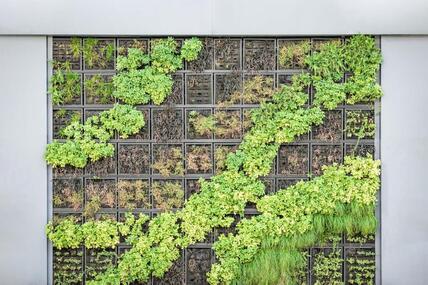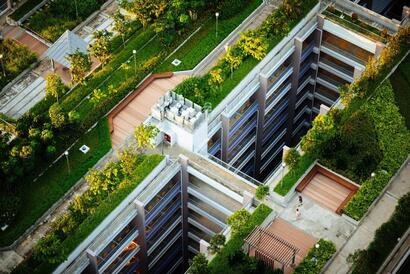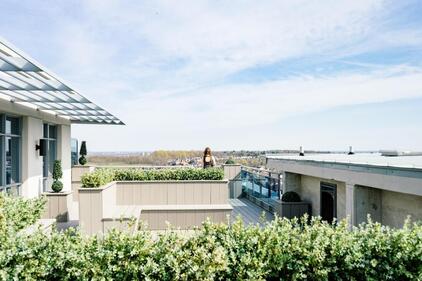 Modern architecture has taken root in Green Architecture. As cities evolve and greenery becomes a coveted asset, merging architecture with nature takes on new dimensions. This revolutionary concept not only redefines the aesthetics of homes but also promises many environmental, psychological, and economic benefits. These innovative green spaces are reshaping how we perceive, design, and experience residential living, promising a harmonious blend of nature and architecture like never before. Nurturing the urban ecosystem: benefits of vertical gardens In the concrete jungles of our cities, a green revolution is quietly taking root. Rooftop paradises and vertical vegetation are not just architectural innovations but champions of sustainability, ushering in a new era of urban design.  Environmental benefits ● Improved air quality and reduced pollution: Rooftop paradises and vertical vegetation act as nature's purifiers, cleansing our air. By absorbing carbon dioxide and exhaling oxygen, they create pockets of fresh air within the urban expanse, reducing pollution and fostering healthier environments. Rooftop paradises and living walls become urban lungs, combatting air pollution with plant-based aesthetics. ● Energy efficiency and temperature regulation: The harmony between plant life and architecture reaches its crescendo in energy efficiency. Green roofs and living walls function as thermal regulators, moderating indoor temperatures and curbing the need for excessive energy consumption. These installations play a vital role in orchestrating a greener future in the symphony of urban landscaping. Aesthetic and psychological benefits ● Enhanced Visual Appeal: Green space integration transforms barren rooftops and plain walls into living art. Rooftop paradises add a splash of nature's palette to the urban canvas, merging architecture with plant-based aesthetics. The result is an enchanting visual tapestry that sparks awe and inspiration. ● Stress reduction and well-being: Like natural tapestries, living walls create a sense of calm and well-being, inviting us to reconnect with nature. Rooftop paradises become sanctuaries of serenity, a counterbalance to the urban hustle. Unlocking urban potential: maximizing limited space ● Utilizing rooftops for greenery: The skyline transforms as rooftops evolve into lush oases. Rooftop paradises showcase the creative potential of urban landscaping, converting previously underutilized spaces into vibrant ecosystems. This transformation not only enhances aesthetic appeal but also contributes to urban biodiversity. ● Transforming unutilized vertical surfaces: Vertical vegetation takes urban landscaping to new heights. Living walls breathe life into blank facades, enveloping them in a tapestry of plant-based aesthetics. This transformation of vertical space adds a new dimension to urban design, redefining how we interact with our surroundings.  Implementing green roofs: design and construction Transforming urban rooftops into vibrant green spaces begins with careful planning and construction. Green roofs, with their environmental benefits and aesthetic allure, come in different types, each requiring thoughtful design and structural considerations. Types of green roofs ● Intensive Green Roofs: These lush, multi-dimensional landscapes captivate the eye and heart. Rooftop paradises of this kind mirror traditional gardens, hosting an array of plant-based aesthetics. These support trees, shrubs, and small recreational areas, turning urban rooftops into idyllic retreats. However, their complexity demands careful planning and substantial structural support, a testament to the transformation they bring to urban landscapes. ● Extensive Green Roofs: Dressed in drought-tolerant and hardy plant varieties, these rooftops thrive with minimal maintenance. Designed for sustainability, they offer a low-maintenance solution to green space integration. Often chosen for locations with limited accessibility, extensive green roofs bear the badge of ecological responsibility. Design considerations The architectural symphony of green roofs hinges on meticulous design considerations, ensuring harmony between nature's vitality and structural integrity. ● Structural requirements and load-bearing capacity: The journey to rooftop paradises begins with structural analysis. Load-bearing capacity assessment is crucial, as green roofs introduce new weight factors. The synergy between structural engineering and urban landscaping manifests in the ability of rooftops to support the lush growth above. ● Plant selection based on climate and maintenance: The composition of green roofs is a symphony of vegetation. Plant-based aesthetics harmonize with local climates and maintenance capabilities. Drought-tolerant plants thrive in arid landscapes, while vibrant varieties flourish in more temperate settings. The art lies in selecting plant ensembles that elevate visual allure while embracing sustainability. ● Construction process: ○ Waterproofing and root barrier installation: The overture to constructing rooftop paradises involves waterproofing – a barrier that safeguards the building beneath from water penetration. This protection extends to root barriers, preventing intrusive growth that could undermine structural integrity. The dance between moisture and urban architecture is choreographed with precision. ○ Soil and drainage layers: The layers of green roofs hold secrets to their vitality. Soil layers foster plant growth, while efficient drainage systems ensure water does not overstay its welcome. The rhythm of saturation and drainage plays a crucial role in preserving rooftops' structural integrity. ○ Planting and growth medium: The crescendo of green space integration unfurls as planting commences. The growth medium becomes the nurturing cradle for plant-based aesthetics. Here, the roots intertwine with the substrate, forming a living symphony of colors, textures, and vitality.  Living walls: bringing nature to vertical spaces Living wall systems As urban landscapes evolve, the concept of vertical vegetation breathes new life into barren walls, introducing green space integration that defies gravity. ● Panel-based systems: Rooftop paradises extend to walls, bringing the charm of nature's palette to architectural canvases. Vertical vegetation forms in pre-planted panels engineered for efficient water distribution and plant-based aesthetics. Panel-based systems integrate plant life into the urban fabric, transforming buildings into living, breathing entities. ● Tray systems: Flexibility graces vertical landscaping with tray systems—these modular arrangements house individual plants, offering a dynamic canvas for plant-based aesthetics. Urban landscaping meets modular artistry as trays can be moved and replaced, evolving with the seasons and artistic visions. Tray systems weave plant-based stories into the very fabric of the city. ● Green facade systems: Nature's ascent is embodied in green facade systems. Climbing plants ascend vertical surfaces, weaving green tapestries against concrete backdrops. These living murals are nurtured by trellises or cables, urban landscaping manifesting as a vibrant, ever-changing spectacle. The harmonious partnership of architecture and plant-based aesthetics thrives vertically. Designing a living wall Vertical vegetation embodies an art form – combining plant choices and careful design. ● Plant choices and arrangements: The palette of plant-based aesthetics takes center stage in living wall design. A choreography of colors, textures, and growth patterns emerges as plant species are selected. Like a painter's strokes, plants are arranged to create balanced, captivating compositions against the canvas of urban architecture. ● Irrigation and water management: The life force of vertical vegetation lies in efficient irrigation. Drip irrigation systems gently nourish each plant, ensuring water reaches every leaf. The orchestration of water management prevents excess while nurturing growth, as urban landscaping meets hydraulic harmony.  Overcoming challenges and ensuring sustainability Creating and maintaining rooftop paradises enriched with plant-based aesthetics and vertical vegetation comes with challenges. However, a commitment to sustainable urban landscaping and green space integration drives the solutions that make these spaces thrive and endure. Addressing maintenance concerns Irrigation and plant care are cornerstones in nurturing these living ecosystems. Automatic irrigation systems carefully calibrated to deliver the right amount of water at the right time ensure that the greenery flourishes. Regular monitoring and adjustments account for changing weather patterns and optimizing water usage for the lush vertical gardens. Meticulous weed control and pest management prevent invasive species from encroaching on the carefully curated plant diversity. Integrated pest management techniques offer effective solutions that minimize the use of harmful chemicals while safeguarding the vitality of green spaces. Financial Considerations Initiating rooftop paradises involves initial costs and long-term savings beyond mere financial investments. While the upfront expenses may be higher than conventional approaches, the benefits are comprehensive and enduring. Green roofs and living walls enhance insulation, reducing energy consumption for heating and cooling. Over time, this translates into significant utility savings, underlining the cost-efficiency of these installations. Recognizing the wider implications of green space integration and its positive impact on urban landscaping, many local governments provide incentives and government support. Tax incentives, grants, and subsidies ease the financial burden of adoption while fostering a greener urban environment. Homeowners and communities can actively contribute to a sustainable, verdant future by understanding the long-term savings and the role of incentives. The journey to establishing and nurturing rooftop paradises is a commitment to a harmonious blend of nature and architecture. With adequate maintenance strategies and a clear understanding of the financial benefits, these living landscapes become resilient symbols of urban sustainability. Written & Submitted by: SOFIA MEDINA Content Marketing Dept. Porch Group | Porch.com
0 Comments
Leave a Reply. |
Categories |

 RSS Feed
RSS Feed